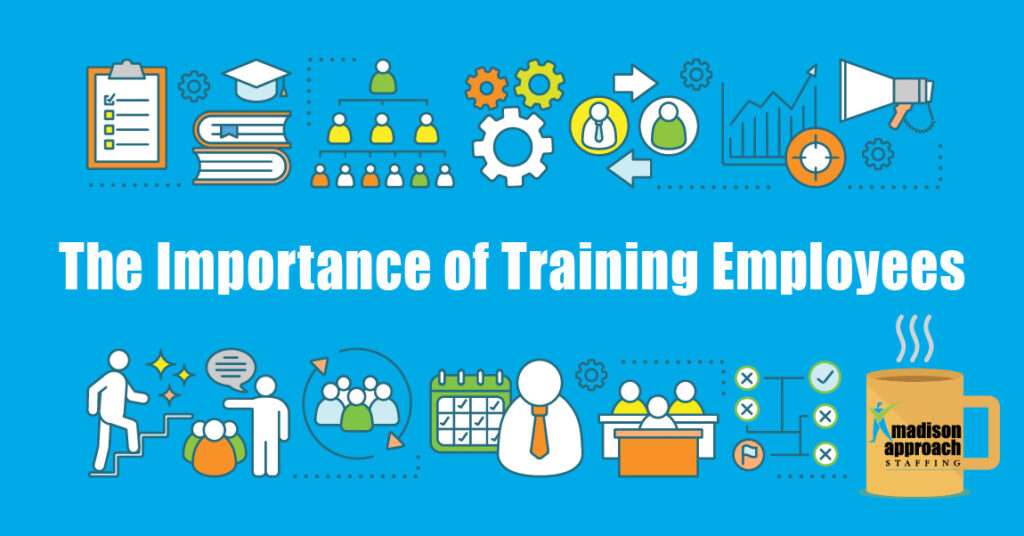The workplace changed drastically since COVID-19 with rapid technology advances and flexible hybrid staffing models implemented to protect employees while maintaining efficient operations. Employers are still scrambling to craft new procedures and policies to keep pace, but what’s become increasingly evident is the need for employers and employees to get in sync regarding specific skills, knowledge and workplace values. Investing in regular, relevant training for employees is the only way to keep your workforce operating at a high level and to stay competitive in the marketplace.
Employers may balk at the cost of training and feel that they can’t afford it. They look at the time to create the training plan, hire a facilitator and materials, rent a classroom, and the lost productivity while still paying wages. But we ask “can you afford not to?”
It’s an important investment for the following reasons:
1) It improves consistency of skills and knowledge: It’s a big time and money waste for employees to work in silos, possibly doing things wrong that need to be fixed later at the company’s expense. Training everyone on desired processes eliminates guesswork, creates consistency, and positively affects productivity, resulting in an increase of profits and customer retention. Nothing will slow the gears down more than questions and confusion. Putting procedures in writing and then training staff will streamline your organization.
2) It satisfies the recommendations of performance appraisals. When an organization’s employee review suggests the need for improvement on a particular subject or skill, organized training programs will satisfy this requirement. It can be deflating for an employee to get a negative review and have no path to learn and improve.
3) It prepares employees for higher responsibilities. Training programs prepare employees to move into higher roles and take on more responsibilitiy in an organization, along with the skills required to function effectively in their new positions. For example, they may be trained in leadership skills, management techniques, or specific software. Training creates a motivated leadership pipeline!
4) It shows employees they are valued. Implementing training programs help employees feel like the company is invested in them. By continuing to teach your employees new skills and abilities, they will not just become productive workers, they will feel like valued members of the organization which will improve morale and confidence. If your workplace employs non-english speakers, ESL classes will go a long way to creating a career pathway for low wage workers and fosters a self-improvement culture.
5) Training improves retention and recruitment. Employee turnover is expensive considering the average cost of replacing an employee can range from one half to two times an annual salary. Additionally, recent polls show that job seekers seek out companies that offer training and that career development opportunities are a deciding factor when applying for a job.
6) Training improves IT and computer skills. Just about every workplace requires some level of computer literacy to function and its no longer acceptable to pass off computer tasks to co-workers “who know computers.” IT training is a must to give employees the knowledge of contemporary technology tools like phone systems, Zoom, WebEx, Outlook, Google drive, and how they work together in an office environment. Training is also needed to instruct employees on specific software systems and best practices. The abrupt transition to remote working online due to COVID caused many people to leave the workforce early because they were uncomfortable with technology.
7) Communications Skills and Diversity Training. Being able to communicate, get along, and resolve conflicts in a healthy, respectful way should not be left to chance. Soft skills need to be taught or an organization can quickly become dysfunctional and combative resulting in lost productivity or even lawsuits.
So to recap; while there are many categories of training and development to consider—Management, Sales, Computer/Technlogy, Communications, Policy & Procedures, Customer Service, Job Skills, English Language, Communication Skills, Diversity—it’s important to assess your workforce, industry competitors, and trends to create a productive training plan that fits your needs.
The many benefits outweigh the cost and we highly recommend making the investment to keep your organization humming along as we break out of our COVID cocoon! Lead on!

